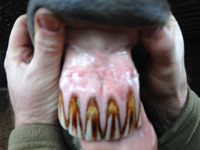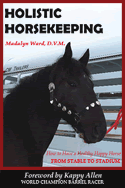March 2018
Equine Odontoclastic Tooth Resorption/Hypercementosis
Holistic Horsekeeping
How to have a healthy happy horse.
Volume 23, Number 3
=*=*=*=*=*=*=*=*=*=*=*=*=*=*=*=*
In This Issue:
1. Equine Odontoclastic Tooth Resorption/Hypercementosis
2. The Holistic Approach to Horse Care
=*=*=*=*=*=*=*=*=*=*=*=*=*=*=*=*
1. Equine Odontoclastic Tooth Resorption/Hypercementosis
 Equine Odontoclastic Tooth Resorption/Hypercementosis (EOTRH) is a condition affecting the incisors and canine teeth of the horse. In this condition one or more incisors becomes loose in the tooth socket. The gum tissue around the loosened tooth will become inflamed and possibly infected. Nodules can be seen at the base of the affected teeth and pus may drain from the area.
Equine Odontoclastic Tooth Resorption/Hypercementosis (EOTRH) is a condition affecting the incisors and canine teeth of the horse. In this condition one or more incisors becomes loose in the tooth socket. The gum tissue around the loosened tooth will become inflamed and possibly infected. Nodules can be seen at the base of the affected teeth and pus may drain from the area.
The body may respond to the loosening of the teeth by resorbing bone at the base of the teeth or by laying down extra cementum in an attempt to stabilize the tooth. The teeth can appear larger than normal, be displaced or fracture. The gum tissue will recede making the teeth appear longer than normal.
EOTRH comes on gradually and early symptoms can easily be missed. Increased salivation is one early sign and later signs include refusal to bite down on a carrot and/or holding the tongue between the teeth. Grumpiness can also be a sign as the condition is extremely painful.
EOTRH is seen primarily in older horses. The cause is not known and the only conventional treatment is extraction of all involved teeth. Horses become immediately less painful immediately after the surgery and are able to be on pasture and softened feed right away. Aftercare includes short term pain relief and gauze packing of the teeth sockets followed by hydrotherapy to flush out packed feed as the wounds heal.
I have a theory about the cause of EOTRH. The dental structure of the horse is very different than in the human. The permanent teeth of the horse will continue to erupt throughout the life of the horse. In a natural environment the incisors are worn down by the constant nipping of grass. The silica content of the grass is abrasive so the incisors wear down when the grass is nipped off and the molars wear with the continued grinding as the grass is broken down into small enough pieces for swallowing. In an ideal situation the teeth erupt at the same rate as the teeth are worn down.
The domesticated horse may not live in a natural environment. Instead of grass, the horse may only have access to hay and processed feeds. There is no nipping action to keep the incisors worn down at the same rate as the molars. To make matters worse, the molars may be regularly floated in a way that further lowers the table surface. If the incisor length is not addressed on a regular basis you can have a situation where the incisors are long enough to prevent to proper contact (occlusion) between the upper and lower molars.
In order to properly grind food the horse will use his jaw muscles to force the molars together. Lack of proper molar occlusion will also cause the incisors of the horse to absorb most of the concussion when the horse is moving around. The combination of increased pressure on the incisors when the horse is attempting to bring the shorter molars into occlusion and concussive forces on the incisors may loosen the teeth over time.
I have seen several cases that appeared to be in the early stages of EOTRH that have responded well to taking the affected incisors out of wear by lowering their table surface with a float. It generally takes only a few millimeters of tooth removal to give the horse relief. The horses I have worked on have accepted this process without sedation of any kind, but sedation would likely be required if the process is more advanced.
I believe EOTRH is being created by our management of the horse and it can be avoided by paying more attention to the proper occlusion of both molars and incisors throughout the life of the horse. Horses that are not on native grass pasture should have the length of their incisors lowered if needed. If the table surface of the molars are lowered through floating then attention should be paid to insure the incisors are not being put under pressure. Consideration of incisor contact could prevent the painful condition of EOTRH as the horse ages.
2. The Holistic Approach to Horse Care
 If you are looking for ways to treat your horse with a holistic approach, Dr. Ward’s book, Holistic Horsekeeping: How to Have a healthy Happy Horse from Stable to Stadium is a good place to start your research. In 139 pages, this book gives you an introduction to the world of holistic medicine and how it compares to natural or alternative approaches. There is also information on using the holistic approach with homeopathy, acupuncture, chiropractic work, osteopathy, nutrition, hoof care, joint health, vaccinations, chronic conditions, training the performance horse and much, much more. If you are new to using a holistic approach with your horse, this is a great resource to help you gain a better understanding of what holistic horse keeping really is. If you are in a more advanced category of learning, consider signing up to mentor with Dr. Ward. This one-on-one study concentrates on an individualized educational program that allows you to gain from Dr. Ward’s long experience in holistic equine treatment.
If you are looking for ways to treat your horse with a holistic approach, Dr. Ward’s book, Holistic Horsekeeping: How to Have a healthy Happy Horse from Stable to Stadium is a good place to start your research. In 139 pages, this book gives you an introduction to the world of holistic medicine and how it compares to natural or alternative approaches. There is also information on using the holistic approach with homeopathy, acupuncture, chiropractic work, osteopathy, nutrition, hoof care, joint health, vaccinations, chronic conditions, training the performance horse and much, much more. If you are new to using a holistic approach with your horse, this is a great resource to help you gain a better understanding of what holistic horse keeping really is. If you are in a more advanced category of learning, consider signing up to mentor with Dr. Ward. This one-on-one study concentrates on an individualized educational program that allows you to gain from Dr. Ward’s long experience in holistic equine treatment.
++++ Copyright | Getting On and Off the List ++++
Unless otherwise attributed, all material is written and edited by Madalyn Ward, DVM. Copyright (c) 2018 HolisticHorsekeeping.com and Madalyn Ward, DVM. All rights reserved.
If you like the material in this newsletter please let your friends know about it. You may reprint material in other electronic or print publications provided the above copyright notice and a link to http://www.holistichorsekeeping.com is included in the credits.
You can get off this list by sending an email to info@holistichorsekeeping.com.
When you forward this material, please send the entire newsletter. Thanks!
Please also enjoy all of Dr. Ward’s web resources:
http://www.holistichorsekeeping.com
http://blog.horseharmony.com
https://www.facebook.com/HolisticHorsekeeping
https://www.facebook.com/HorseHarmony
Twitter: madalynward